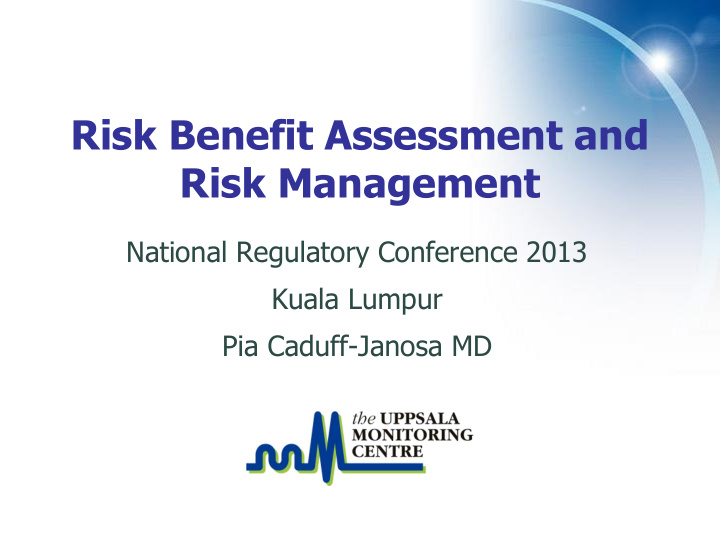



Risk Benefit Assessment and Risk Management National Regulatory Conference 2013 Kuala Lumpur Pia Caduff-Janosa MD
Outline • Risk versus perception • How much risk is acceptable? • Risk assessment • PV Planning and risk management: ICH E2E • Risk minimizing action • The power of communication Pia Caduff-Janosa, Uppsala Monitoring Centre
Risk • a situation involving exposure to danger (Oxford Dictionary) • A probability or threat of damage, injury, liability, loss, or any other negative occurrence that is caused by external or internal vulnerabilities, and that may be avoided through preemptive action (http://www.businessdictionary.com/definition/risk. html#ixzz2MxJoKUms) Pia Caduff-Janosa, Uppsala Monitoring Centre
Risk Perception Individual judgement influenced by • Quality of risk – Natural/human made – Catastrophic/chronic – Familiar/new – Imposed/voluntary • Population affected – Vulnerable (children, pregnant) – Known victims Pia Caduff-Janosa, Uppsala Monitoring Centre
• Control • Uncertainty • Awareness • Risk vs benefit www.nieman.harvard.edu/reportsitem.aspx Pia Caduff-Janosa, Uppsala Monitoring Centre
How much risk is acceptable? • Choice made by individuals for themselves – Risk- benefit analysis at personal level • Choice made by institution/authority for the population – Risk – benefit anlalysis at population level Different conclusions possible Pia Caduff-Janosa, Uppsala Monitoring Centre
Risk Assessment • Severity and seriousness of ADR • Preventability • Size of population exposed – Vulnerable populations? • Essential medicine? • Therapeutic alternatives • Rapid increase of ADR reports • Impact on public opinion Pia Caduff-Janosa, Uppsala Monitoring Centre
ICH Guideline E2E INTERNATIONAL CONFERENCE ON HARMONISATION OF TECHNICAL REQUIREMENTS FOR REGISTRATION OF PHARMACEUTICALS FOR HUMAN USE ICH HARMONISED TRIPARTITE GUIDELINE PHARMACOVIGILANCE PLANNING E2E Pia Caduff-Janosa, Uppsala Monitoring Centre
ICH E2E • Recommended for adoption November 2004 • Focus on documents to be submitted when apllying for a marketing authorization – Safety Specification – Pharmacovigilance Plan • For new chemical entities or products with major changes – Populations, indications, dosage, formulation, manufacturing etc Pia Caduff-Janosa, Uppsala Monitoring Centre
Safety Specification • Identified risks – Preclinical findings not adressed/resoved in clinical phase • Potential risks – General pharmacology – Interactions – Toxicity • Important missing information – Populations not studied Pia Caduff-Janosa, Uppsala Monitoring Centre
Pharmacovigilance Plan • Based on Safety Specification • Ongoing safety issues – From clinical development and/or postauthorization • Routine PV – Spontaneous reporting – PBRER • Action plan for safety issues incl. Milestones – Objective/rationale/monitoring – Milestones for evaluation and reporting Pia Caduff-Janosa, Uppsala Monitoring Centre
Benefit/risk balance • Benefit/risk balance must always be favourable but – Benefit at individual level and – Benefit at population level can differ Pia Caduff-Janosa, Uppsala Monitoring Centre
Benefit/Risk Assessment • Natural course and epidemiology of disease • Who is at risk/who benefits? – Special populations? – Risk factors? • Magnitude of risk/of benefit? – Efficacy = benefit? – Surrogate markers • Preventability/risk mitigation • Risks/benefits of alternative treatments Pia Caduff-Janosa, Uppsala Monitoring Centre
Comparative Risk Evaluation • Medicinal products with different time on the market • Information mainly from spontaneous reporting systems • ADRs may differ in clinical significance and not be easily comparable Pia Caduff-Janosa, Uppsala Monitoring Centre
Transparency • Publication of PV Plans – ANSM (DRA France) • Publication of Evaluation Reports – EMA: EPAR (European Public Assessment Report) • Approved Risk Evaluation and Mitigation Strategies (REMS) – US FDA Website Pia Caduff-Janosa, Uppsala Monitoring Centre
Risk Minimizing Action • Watch and wait • Gather more information • Inform • Restrict use • Restrict availability • Suspend • Withdraw Pia Caduff-Janosa, Uppsala Monitoring Centre
But above all... Pia Caduff-Janosa, Uppsala Monitoring Centre
Communication • Product information • Health Care Professional Communication • Scientific paper • DRA website • PV Newsletter • Press release • Stable working relationship with media Pia Caduff-Janosa, Uppsala Monitoring Centre
The ”side effects” of information Well informed – HCP will prescribe more rationally – Patients/consumers will be more alert More reports on potential safety issues will reach the PV centre/DRA ( reporting bias ) Better collaboration within the PV community Pia Caduff-Janosa, Uppsala Monitoring Centre
Conclusions • Risk perception is as important as absolute risk • Acceptabilty of risk is difficult to quantify • Risk and benefit go hand in hand • Comparative assessment is a difficult ”must” • Transparency and communication are our best friends Pia Caduff-Janosa, Uppsala Monitoring Centre
Uppsala Monitoring Centre Box 1051 SE-751 40 Uppsala, Sweden Visiting address: Bredgränd 7, Uppsala tel +46 18 65 60 60 fax +46 18 65 60 88 website www.who-umc.org Pia Caduff-Janosa, Uppsala Monitoring Centre
Recommend
More recommend